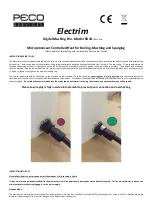
PROGRAMING WITHOUT THE PAMUX DRIVER
Pamux User’s Guide
4-11
Normal under-range values are returned as a 16-bit twos-complement number (i.e., FFFF hex = -1,
FFFE = -2, FFFD = -3, etc.). Input channels that do not have modules installed will return -4096 (F000
hex). Input modules that receive signals too far under range (below 1.25% of span) will stop relaying
data to the CPU. When this happens, the data returned will be -4096. This can occur when a 4–20
milliampere signal goes below 3.8 milliamperes, or when a thermocouple input becomes an open
circuit.
CONFIGURING AND WRITING TO ANALOG CHANNELS
The Pamux analog brain board configures all channels as inputs on power-up or after a reset. Thus, if
you are using output modules, they must be configured before they can be turned on.
To configure a channel as an output, you must set the module position’s bit to 1 in the configuration
register. The configuration register is found at location 7E and 7F hex.
For example, if module positions 0, 1, and 3 are outputs, the configuration byte would be 0B, as
indicated below:
Position:
7 6 5 4 3 2 1 0
Bits:
0 0 0 0 1 0 1 1 = 0B hex
With this information, you are ready to configure the channels. First you must gain access, as
described previously. Next, write the address of the configuration register to the control register.
Finally, write the configuration byte to the data register.
Once you have configured the channels, you are ready to write a value to an analog position. Writing
is the reverse of reading. The steps are as follows:
1.
Write the position of the analog channel’s least significant byte to the control register.
2.
Write the least significant byte to the data register.
3.
Increment the control register.
4.
Write the most significant byte to the data register.
Summary of Contents for PAMUX
Page 10: ...TABLE OF CONTENTS x Pamux User s Guide...
Page 14: ...TABLE OF CONTENTS xiv Pamux User s Guide...
Page 103: ...PROGRAMING WITH THE PAMUX DRIVER 3 42 Pamux User s Guide...
Page 121: ...PROGRAMING WITHOUT THE PAMUX DRIVER 4 18 Pamux User s Guide...
Page 125: ...TROUBLESHOOTING AND TIPS A 4 A 4 A 4 A 4 A 4 Pamux User s Guide...
Page 135: ...SPECIFICATIONS B 10 Pamux User s Guide...
Page 141: ...TEMPERATURE CONVERSIONS ROUTINES C 6 Pamux User s Guide...
Page 143: ...PRODUCT SUPPORT D 2 Pamux User s Guide...
Page 149: ...GLOSSARY E 6 Pamux User s Guide...
















































